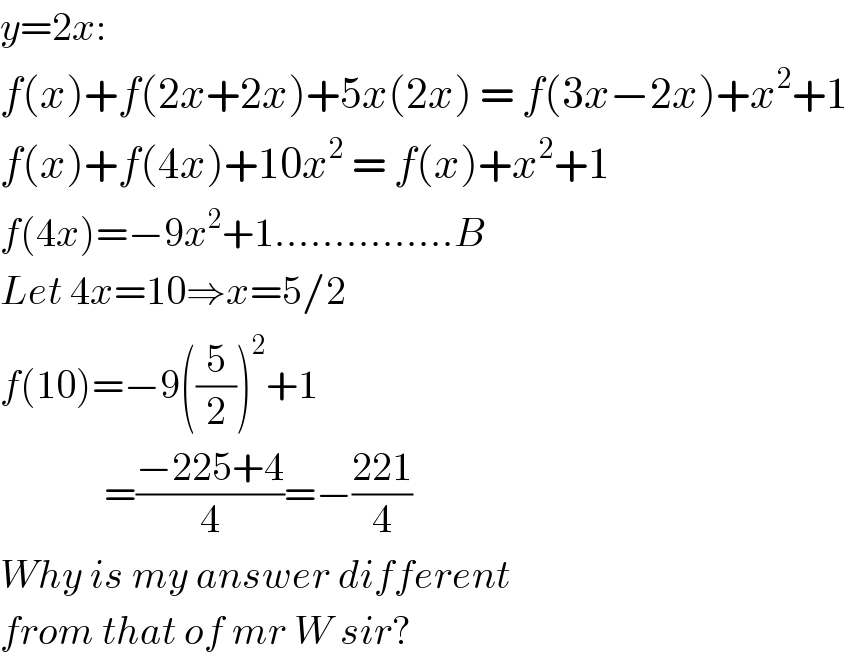Question Number 109262 by bemath last updated on 22/Aug/20

$${f}\left({x}\right)+{f}\left(\mathrm{2}{x}+{y}\right)+\mathrm{5}{xy}\:=\:{f}\left(\mathrm{3}{x}−{y}\right)+{x}^{\mathrm{2}} +\mathrm{1} \\ $$$${for}\:{every}\:{x},{y}\in\mathbb{R}\:.\:{find}\:{f}\left(\mathrm{10}\right) \\ $$
Answered by mr W last updated on 22/Aug/20

$${y}=\mathrm{0}: \\ $$$${f}\left({x}\right)+{f}\left(\mathrm{2}{x}\right)\:=\:{f}\left(\mathrm{3}{x}\right)+{x}^{\mathrm{2}} +\mathrm{1}\:\:\:…\left({i}\right) \\ $$$${y}={x}: \\ $$$${f}\left({x}\right)+{f}\left(\mathrm{3}{x}\right)+\mathrm{5}{x}^{\mathrm{2}} \:=\:{f}\left(\mathrm{2}{x}\right)+{x}^{\mathrm{2}} +\mathrm{1}\:\:\:…\left({ii}\right) \\ $$$$\left({i}\right)+\left({ii}\right): \\ $$$$\mathrm{2}{f}\left({x}\right)+{f}\left(\mathrm{2}{x}\right)+{f}\left(\mathrm{3}{x}\right)+\mathrm{5}{x}^{\mathrm{2}} ={f}\left(\mathrm{3}{x}\right)+{x}^{\mathrm{2}} +\mathrm{1}+{f}\left(\mathrm{2}{x}\right)+{x}^{\mathrm{2}} +\mathrm{1} \\ $$$$\mathrm{2}{f}\left({x}\right)=−\mathrm{3}{x}^{\mathrm{2}} +\mathrm{2} \\ $$$$\Rightarrow{f}\left({x}\right)=−\frac{\mathrm{3}}{\mathrm{2}}{x}^{\mathrm{2}} +\mathrm{1} \\ $$$$\Rightarrow{f}\left(\mathrm{10}\right)=−\frac{\mathrm{3}}{\mathrm{2}}×\mathrm{10}^{\mathrm{2}} +\mathrm{1}=−\mathrm{149} \\ $$
Answered by Rasheed.Sindhi last updated on 22/Aug/20

$${y}=\mathrm{2}{x}: \\ $$$${f}\left({x}\right)+{f}\left(\mathrm{2}{x}+\mathrm{2}{x}\right)+\mathrm{5}{x}\left(\mathrm{2}{x}\right)\:=\:{f}\left(\mathrm{3}{x}−\mathrm{2}{x}\right)+{x}^{\mathrm{2}} +\mathrm{1} \\ $$$${f}\left({x}\right)+{f}\left(\mathrm{4}{x}\right)+\mathrm{10}{x}^{\mathrm{2}} \:=\:{f}\left({x}\right)+{x}^{\mathrm{2}} +\mathrm{1} \\ $$$${f}\left(\mathrm{4}{x}\right)=−\mathrm{9}{x}^{\mathrm{2}} +\mathrm{1}……………{B} \\ $$$${Let}\:\mathrm{4}{x}=\mathrm{10}\Rightarrow{x}=\mathrm{5}/\mathrm{2} \\ $$$${f}\left(\mathrm{10}\right)=−\mathrm{9}\left(\frac{\mathrm{5}}{\mathrm{2}}\right)^{\mathrm{2}} +\mathrm{1} \\ $$$$\:\:\:\:\:\:\:\:\:\:\:\:\:=\frac{−\mathrm{225}+\mathrm{4}}{\mathrm{4}}=−\frac{\mathrm{221}}{\mathrm{4}} \\ $$$${Why}\:{is}\:{my}\:{answer}\:{different}\: \\ $$$${from}\:{that}\:{of}\:{mr}\:{W}\:{sir}? \\ $$
Commented by mr W last updated on 22/Aug/20

$${it}\:{means}\:{that} \\ $$$${f}\left({x}\right)+{f}\left(\mathrm{2}{x}+{y}\right)+\mathrm{5}{xy}\:=\:{f}\left(\mathrm{3}{x}−{y}\right)+{x}^{\mathrm{2}} +\mathrm{1} \\ $$$${is}\:{not}\:{consistent}\:{because}\:{it}\:{leads}\:{to} \\ $$$${contradiction}. \\ $$
Commented by Rasheed.Sindhi last updated on 22/Aug/20

$${Sir}\:{how}\:{can}\:{they}\:{be} \\ $$$${differentiated}\:{from}\:{the} \\ $$$$'{cosistent}\:{functional}\:{equations}'? \\ $$$$ \\ $$
Commented by mr W last updated on 22/Aug/20

$${i}\:{can}'{t}\:{exactly}\:{explain}\:{where}\:{the} \\ $$$${error}\:{lies}. \\ $$
Commented by Rasheed.Sindhi last updated on 22/Aug/20

$$\mathbb{T}\mathrm{han}\Bbbk\mathrm{s}\:\mathrm{sir}! \\ $$
